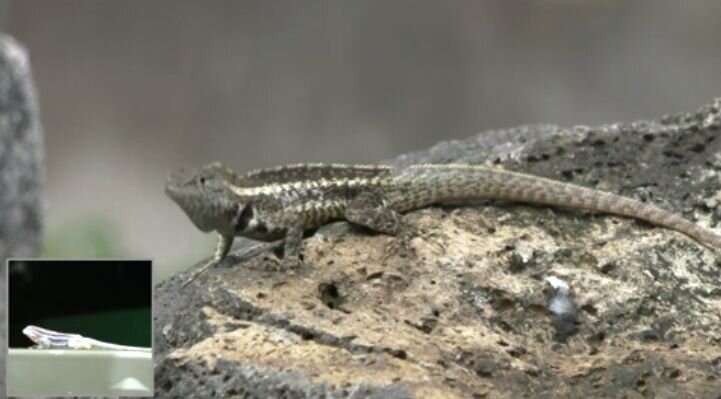Realistic robots get under Galapagos lizards' skin

Male lava lizards are sensitive to the timing of their opponents' responses during contest displays, with quicker responses being perceived as more aggressive, a study in Behavioural Ecology and Sociobiology suggests.
To avoid injury from male-to-male contests, some animal species display behaviours such as color changes or sequences of movements that showcase body size and fighting ability. In lizards, one of the most recognised behaviours is the bobbing or pushup display.
Dr. David Clark at Alma College, US and colleagues investigated whether lizards would react more quickly and strongly to their opponent's bobbing display, if that display occurred immediately or with a delay following an initial challenge. The authors used remote-controlled realistic lizard robots made from hand carved wood, high resolution photos and latex limbs to simulate an opponent's reaction to a wild lizards' display.
The authors positioned lizard robots approximately 1-3m from 20 wild Galápagos Lava Lizards (Microlophus bivitattus) found on the island of San Cristóbal. After provoking an initial response by the native lizard, the researchers remotely activated the lizard robot to respond with a pre-set counter movement either immediately, or after a 30-second delay.
Dr. David Clark, the corresponding author of the study said: "We had hypothesized that our Lava Lizard subjects would respond differently if the robot responded immediately to their bobbing display than if the response from the robot was delayed. The results suggest that our hypothesis was correct. We found that an immediate response by the robot stimulated the wild lizard to respond more quickly and significantly more often than when the robot's response was delayed by 30 seconds."
The authors suggest that the live lizards may have perceived a rapid response from their robotic contestant as more aggressive than a delayed response. This ability to assess their contestant's level of aggression may help the lizard size up their competitor and may influence their decision to retreat or instigate a contest, helping them avoid disadvantageous injury.
Dr. Clark said: "Ours is the first study to use a lizard robot that interacts with wild subjects in real-time. Previous research in this area has used either pre-recorded video playback or robots with movements set on a "loop". The findings confirm that realistic robotic stimuli can be used to interact with animals, to communicate with them and even manipulate their behaviour. Our results further our understanding of how lava lizards communicate with each other in their natural habitat."
The authors say that bobbing display communication in lizards could now be explored further by altering display speeds, bobbing height and the distance between the robot and subject.
More information: David L. Clark et al, Galápagos lava lizards (Microlophus bivittatus) respond dynamically to displays from interactive conspecific robots, Behavioral Ecology and Sociobiology (2019). DOI: 10.1007/s00265-019-2732-6
Journal information: Behavioral Ecology and Sociobiology , Behavioural Ecology and Sociobiology
Provided by Springer



















